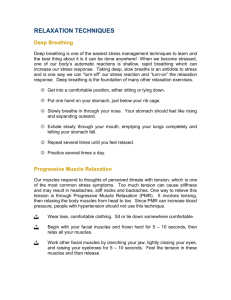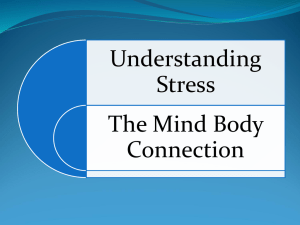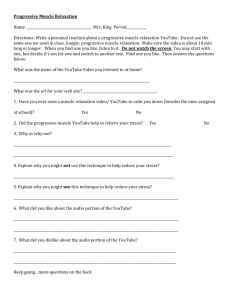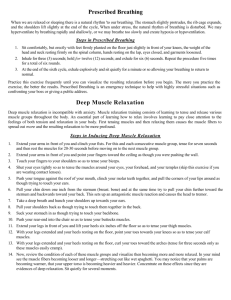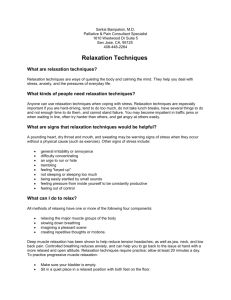Shy No Longer: Module 3 - Progressive Muscle Relaxation
advertisement
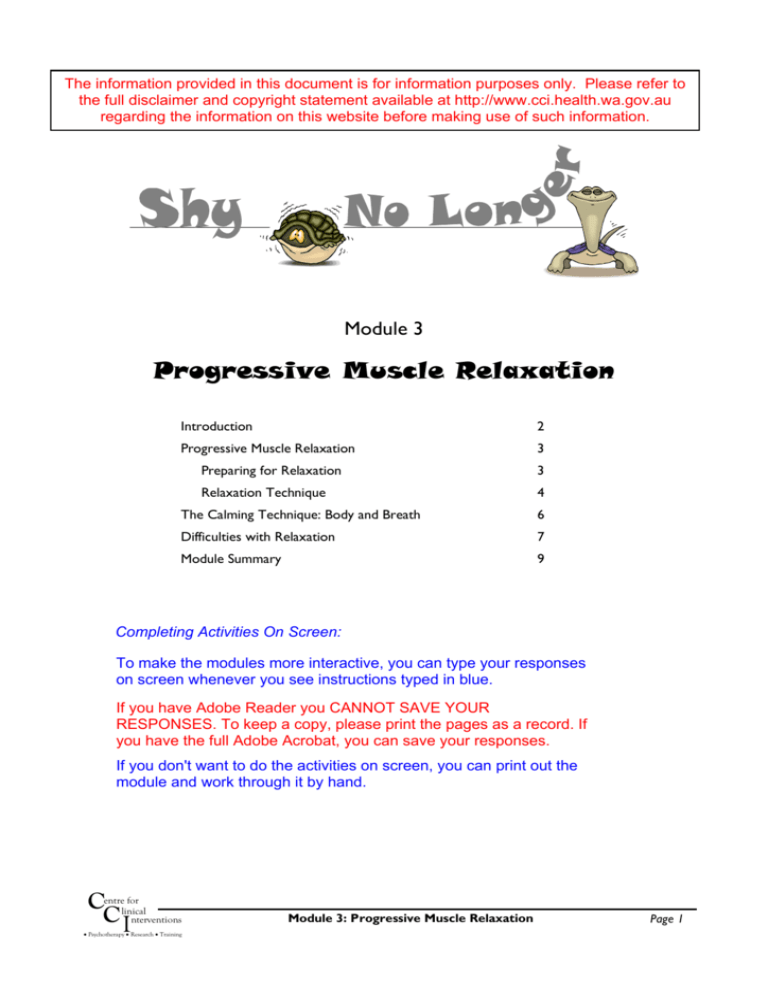
Shy No Longer The information provided in this document is for information purposes only. Please refer to the full disclaimer and copyright statement available at http://www.cci.health.wa.gov.au regarding the information on this website before making use of such information. Module 3 Progressive Muscle Relaxation Introduction 2 Progressive Muscle Relaxation 3 Preparing for Relaxation 3 Relaxation Technique 4 The Calming Technique: Body and Breath 6 Difficulties with Relaxation 7 Module Summary 9 Completing Activities On Screen: To make the modules more interactive, you can type your responses on screen whenever you see instructions typed in blue. If you have Adobe Reader you CANNOT SAVE YOUR RESPONSES. To keep a copy, please print the pages as a record. If you have the full Adobe Acrobat, you can save your responses. If you don't want to do the activities on screen, you can print out the module and work through it by hand. C CI entre for linical nterventions • Psychotherapy • Research • Training Module 3: Progressive Muscle Relaxation Page 1 Shy No Longer Introduction Learning to change your breathing habits can help to reduce general levels of anxiety. Once you’ve practiced the calming technique consistently, it can be especially helpful in anxious situations. Another helpful strategy is to practise using muscle relaxation techniques. You may recall from Module 1 that one of the body reactions in the fight/flight response is muscle tension. This can result in feeling “tense”, or can lead to muscle aches and pains, as well as leaving some people feeling exhausted. Think about how you respond to anxiety. Do you “tense up” when you’re feeling anxious? Sometimes the change may be so subtle that we don’t even notice it happening, but perhaps you clench your teeth slightly so your jaw ends up feeling tight, or maybe your shoulders become tense, resulting in a feeling of tightness in your neck and shoulders. Muscle tension can also be associated with backaches, muscle spasms, and tension headaches. Different people respond to anxiety with muscle tension in different parts of the body and to different extents. Muscle Tension Scan Consider your own body for a moment. You may have noticed that in the past certain parts of your body felt tense, especially after a stressful day or a particularly anxious experience. Where do you often feel tension and “tightness” in your body? Click on the relevant boxes below and type any other areas where you feel muscle tension Forehead Shoulders Lower legs Mouth and/or jaw Arms Other: Neck Back Other: Chest Upper legs Other: Don’t worry if you can’t remember all the different places that you feel tension. This is just to help you to start thinking about muscle tension in your body. If you want to keep a record of your responses, you'll need to print out this page Muscle relaxation can be particularly helpful in cases where anxiety is especially associated to muscle tension. It can help to interrupt the development of anxiety by providing you with the skills to respond differently to muscle tension. This module is designed to help you reduce the tension that you may experience as a result of anxiety. C CI entre for linical nterventions • Psychotherapy • Research • Training Module 3: Progressive Muscle Relaxation Page 2 Shy No Longer Progressive Muscle Relaxation One method of reducing muscle tension is through a technique called Progressive Muscle Relaxation. Relaxation based on this method has been used for many years. Many people have found it helpful in reducing muscle tension that has resulted from prolonged periods of anxiety. In progressive muscle relaxation exercises, you tense up particular muscles and then relax them, and then you practise this technique consistently. There are a few important steps involved in learning how to use progressive muscle relaxation. 1. Differentiating between muscle groups. For those of us who don’t think about our muscles very often, when we try to tense up our hand and forearm, we may end up tensing our whole arm. Learning this technique involves learning to tense and relax specific parts of our body. 2. Learning how to tense different muscle groups and what that tension feels like 3. Allowing yourself to relax and let go of the tension 4. Practice, practice, practice and more practice The technique is relatively simple, although it may take a while to get used to it. After all, it is a normal fight/flight response to tense your muscles in response to fear. However, by practicing to relax your muscles in response to tension, your body can learn to cope better with anxious situations where the fight/flight response is not essential for survival. This tensing and relaxing of muscles helps you to become more aware of the sensations of tension in your muscles and increases your ability to relax them. Preparing for Relaxation When you are beginning to practice progressive muscle relaxation exercises there are some points to keep in mind. This will help you to take full advantage of the exercises. You need to prepare your mind, body and the environment for relaxation. - Physical injuries. If you have any injuries, such as sporting injuries, or have a history of physical problems that may cause muscle pain, you should consult your doctor before attempting any muscle relaxation exercises. Talk to your doctor if you have any concerns or queries about how these exercises may affect you. - Select your surroundings. When you first learn to use these techniques, think about minimising the distraction to your five senses. Turn off the TV, the radio, take the phone off the hook, have soft lighting and so on. For most people who have a family, this can sometimes be a challenge. - Make yourself comfortable. Try to find a chair that comfortably seats your whole body, including your head. For example, a reclining sofa is more beneficial than a kitchen chair. Wear loose, comfortable clothing and take off your shoes. This all helps with providing a comfortable environment for your body to relax. - Internal mechanics. Avoid practicing after big, heavy meals, and do not practice after consuming any intoxicants, such as alcohol. - Practice means progress. Only through practice can you become more aware of your muscles, how they respond with tension, and how you can relax them. Training your body to respond differently to stress is like any training – practising consistently is the key. C CI entre for linical nterventions • Psychotherapy • Research • Training Module 3: Progressive Muscle Relaxation Page 3 Shy No Longer Relaxation Technique The following section describes the relaxation programme. This includes the general procedure, a full description of how to tense particular muscle groups, and the order in which to tense and relax them. Once you are familiar with the routine and understand how to tense particular muscle groups, you can use the brief outline of the procedure as a quick guide to how to do the full programme. GENERAL PROCEDURE 1. Choose your surroundings and make yourself comfortable, as described in the previous section. 2. Use the calming technique described in Module 2 to help you let go of the stress and anxiety that may have existed in your day so far. Do this for 3-5 breaths. Calming Technique: • Breathe in for 4 seconds (through your nose) • Hold for 2 seconds • Breathe out for 6 seconds (If you are still getting used to changing your breathing, use a 2-in, 1-hold, and 3-out cycle) 3. When you are ready to begin, tense the muscle group described. • Make sure you can feel the tension, but not so much that you feel a great deal of pain. • It is more important to focus on what the tension feels like and how the tension builds up, rather than trying to overstrain the muscle. • Keep the muscle tensed for approximately 5 seconds. 4. Relax the muscles • Relax the muscle, and keep it relaxed for approximately 10 seconds • It may be helpful to say something like “Relax” as you relax the muscle. • Focus on the difference between how the muscle feels when it is relaxed compared to when it is tense. 5. You can tense and relax each muscle group twice before moving on to the next muscle group. 6. When you have finished the relaxation procedure, remain seated for a few moments allowing yourself to become alert. Continue your breathing exercises using the calming technique, and get up slowly. RELAXATION SEQUENCE 1. Right hand and forearm. Make a fist with your right hand. Focus on the tension in your hand and your arm (below the elbow) and hold the tension for 5 seconds. Relax your hand and arm, releasing the tension for about 10 seconds. Notice the difference between the tension and the relaxation. 2. Right upper arm. Bring your right forearm up to your shoulder. The closer you bring your hand to your shoulder, the more tense your upper arm will become. Focus on the muscles in between your elbow and your shoulder - try not to tense your forearm or your hand too much. Hold the tension for 5 seconds, then release for 10 seconds. 3. Left hand and forearm. Repeat as for right hand and forearm. 4. Left upper arm. Repeat as for right upper arm. C CI entre for linical nterventions • Psychotherapy • Research • Training Module 3: Progressive Muscle Relaxation Page 4 Shy No Longer 5. Forehead. Focus on your face now, raising your eyebrows as high as they will go, as though you were surprised by something. Feel the tightness in the muscles above your eyes. When you release the tension of the muscles around your forehead, focus on them becoming smooth and relaxed. 6. Eyes and cheeks. Squeeze your eyes tight shut. Focus on the tension around your eyes and your cheeks. Notice how the tension is released as you relax those muscles. 7. Mouth and jaw. Open your mouth as wide as you can, as some people do when they have a big yawn. Feel all the muscles in the hinge of your jaw tightening, and notice the tension around your mouth. When you relax your mouth and jaw you can leave your lips slightly apart and just let your jaw hang freely. 8. Neck. !!! Be careful as you tense these muscles. Focus on the muscles in your neck by facing forward and then pulling your head back slowly, as though you are looking up to the ceiling. Feel the tension in the muscles in the back of your neck, as this is often an area that becomes tense. Relax these muscles by bringing your head back down to a loose, resting position, noticing how the tension is released. 9. Shoulders. Tense the muscles in your shoulders as you bring your shoulders up towards your ears. Focus on the tightness in your shoulders. Hold it for 5 seconds, and then let go of the tension by dropping your shoulders right down to a relaxed position. It is very common for people to keep tension in their shoulders, so notice the comparison between tensed and relaxed. 10. Shoulder blades/Back. Push your shoulder blades back, trying to almost touch them together, so that your chest is pushed forward. Hold the tension in the muscles, feeling the tightness in your upper back and in your shoulder blades. Release the tension by dropping your shoulders into a resting, relaxed posture, feeling the tension fade away. 11. Chest and stomach. Breathe in deeply, filling up your lungs and chest with air. Feel the tension in your chest and stomach muscles. Hold it for 5 seconds, and as you slowly breathe out, feel the muscles relaxing. 12. Hips and buttocks. Squeeze your buttock muscles, noticing the tension in your buttocks and hips. Try not to tense up your legs, just focus on tightening up the buttock and hip muscles. Relax the muscles, and feel them loosen up. 13. Right upper leg. Tighten your right thigh, concentrating on the tension in that area. You may get some tension in your hip and in your calf muscle, but try to focus most of the tension in your thigh muscle. Release the tension and feel the muscle relax. 14. Right lower leg. !!! Do this slowly and carefully to avoid cramps. Pull your toes towards you to feel the tightness in your calf muscle. Hold it, then relax it and notice all the tension fade away from the muscle. 15. Right foot. Curl your toes downwards to feel the tension in your right foot. Hold the tension and then relax your toes, bringing them into their normal resting position. 16. Left upper leg. Repeat as for right thigh. 17. Left lower leg. Repeat as for right calf. 18. Left foot. Repeat as for right foot. C CI entre for linical nterventions • Psychotherapy • Research • Training Module 3: Progressive Muscle Relaxation Page 5 Shy No Longer The Calming Technique: Body and Breath Follow this guide to practise a calming technique in which you will be controlling your breathing and relaxing your muscles. This is a shorter method of relaxation than the full progressive muscle relaxation exercise. Make sure you are sitting comfortably and relaxed. You may find it easier to close your eyes while you are doing this exercise. CALMING YOUR BREATH Using your nose to breathe in and your mouth to breathe out, start by observing your breath. Note the quality of your breath as you inhale and exhale… • Now try to slowly lengthen each inhalation by drawing your breath down towards the abdominal area in a smooth and steady fashion. Have a brief pause before you observe the slow, smooth and steady fashion in which your breath is released as you exhale. • Now that you are paying attention to your breath, you are ready to commence the counting rhythm: Breathing in 2, 3, 4 Hold for 2 Breathing out 2, 3, 4, 5, 6 Try to maintain this slow, even, and controlled rhythm in your breathing by continuing to count in your head. CALMING YOUR BODY Next, start paying attention to your body, scanning it for areas of muscular tension. To do this, try to work with the rhythm of your breathing, by scanning and observing your body as you inhale, and releasing tension as you exhale. Try to observe, 2, 3, 4 Hold, for 2 Release 2, 3, 4, 5, 6 It may help to scan your body in a systematic fashion, for example, by directing your attention from the bottom up • That is, you may start with observing whether there is any muscular tension in your feet, ankles, and calf muscles, and releasing tension in those muscles as you exhale in a slow and steady fashion…letting go of tension in these areas each time you breathe out. Become aware of your feet resting heavily and comfortably on the floor • Next, direct your attention upwards; observe your thighs, buttocks, and hips as you breathe in….releasing muscular tension with each slow, and steady exhalation. • Draw your attention to your abdominal region, scanning for tension in the form of knots or butterflies, releasing tension each time you breathe out…. • Next, scan your upper body for muscular tension. Observe areas of tension as you inhale slowly to the count of four…and release tension as you slowly exhale to the count of six. • Pay some attention to your shoulder region, observing signs of tension and releasing tension with each exhalation, allowing your shoulders to sink down and rest low. • Observe whether there is any muscular tension in your hands, wrists, and arms, and releasing tension in those muscles as you exhale in a slow and steady fashion…letting go of tension in those areas each time you breathe out….Become aware of your hands and arms resting heavily and comfortably. • Once again, direct your attention upwards, back towards the shoulder region, observing and releasing tension as you slowly and steadily breathe in and out…. • Observe the sensation in your neck…scanning for tension and releasing tension as you exhale. See if you can find the point of balance where your head balances most comfortably and effortlessly on the top of your neck. • Next, direct your attention towards your facial muscles, starting with your forehead and brow, releasing any tension and smoothing these areas each time you breathe out…. • Observe tensions around your eyes, releasing tensions each time you exhale, allowing your eyeballs to fall back into their sockets. • Take note of muscular tension in and around your mouth and jaw, allowing your lips to relax, your jaws to unclench and your tongue to settle more heavily in the bottom of your mouth each time you breathe out. …. C CI entre for linical nterventions • Psychotherapy • Research • Training Module 3: Progressive Muscle Relaxation Page 6 Shy No Longer Now that you have scanned most of the common areas for muscular tensions, continue to breathe slowly, smoothly, and steadily, maintaining your count…inhaling to the count of 4, holding your breath for the count of 2, and exhaling to the count of 6…. For the final few moments, you may wish to redirect your attention to any part of your body in which you are still aware of muscular tension and attempt to gradually release more and more tension each time you exhale. If you notice that your mind is starting to wander, do not make yourself tense in trying to stop your thoughts. Simply observe your mind’s activity as you slowly inhale and release the thoughts as you breathe out, observing the thoughts drift away…. Throughout try to maintain the slow and steady rhythm of breathing in, 2, 3, 4, hold for 2, and out, 2, 3, 4, 5, 6…. Finally, see if you can maintain the nice and evenly controlled quality of your breath as you cease counting, become aware of your surroundings, and get ready to open your eyes…. Difficulties with Relaxation Sometimes, especially when people first start using relaxation techniques, it may feel quite unusual. Some people feel uncomfortable with how their body responds to relaxation or they may feel like it isn’t working. Some of these difficulties include: • Fear of losing control: Sometimes people feel like they may lose control, perhaps because they have never used relaxation techniques before and don’t know what to expect, or perhaps it is so different to what they’re used to that they’re not sure what will happen. Remind yourself that we are in control of our mind, body and feelings and that relaxation can be stopped at any time. • Unusual bodily sensations: Some people feel tingling or hot and/or cold sensations, ‘jumping’ muscles or heaviness in the limbs. These are all normal sensations which are experienced as we loosen up and become more aware of the different muscles in the body. • Limited success in the beginning: Relaxation is a skill like any other. The more you practice the easier it gets, so try to persevere with your relaxation sessions. • A wandering mind: Turtle Tip When an individual begins practising relaxation exercises, they may have difficulty concentrating or focusing on what they are supposed to be doing. This may be frustrating. If your mind starts to wander, just allow the thought to pass by, and then bring your attention back to the relaxation exercise. Once you have practised PMR and know how to relax your muscles, you might wish to use a version of the calming technique that focuses on relaxing your breath and your body. C CI entre for linical nterventions • Psychotherapy • Research • Training Learning to train your body to respond differently takes time. It might feel strange at first, but practising is the key to getting your body used to relaxing. Module 3: Progressive Muscle Relaxation Page 7 Date & Time The most relaxed and 0 1 3 4 5 Comments / Reactions 2 6 7 8 9 Relaxation level after The most tense or anxious Relaxation level before 10 What sensations were you aware of in your body? Was your mind relaxed? What sorts of images were most relaxing for you? • • • • Psychotherapy • Research • Training for Centrelinical C Interventions What parts of your body relaxed easily? • Comments / Reactions: It is important to practice relaxation to achieve the best results, as this is a new skill that you are learning. You can monitor you own progress by keeping a relaxation diary that records the when, where and how of your practice. This will help you to identify particular situations and / or times of the day when you are most tense. Use the scale to indicate your level of relaxation before and after you complete your relaxation. Monitoring Your Relaxation Level Why not print this page now and use it during the week? Shy No Longer Module Summary • Muscle tension is a common symptom of anxiety. One method of reducing muscle tension is through a technique called progressive muscle relaxation. In progressive muscle relaxation exercises, you tense up particular muscles and then relax them, and then you practise this technique consistently. • Progressive Muscle Relaxation involves learning to differentiate between different muscle groups, learning how to tense each muscle group separately, allowing yourself to relax and let go of the tension, and consistent practice sessions as the key to successful relaxation. • When preparing for relaxation, you need to consider the following” • • • • be aware of any injuries, make your surroundings and your body as comfortable and distraction-free as possible, avoid practising after heavy meals or alcohol, and remember that the key to progress is practise! • Progressive Muscle Relaxation starts with the calming technique to slow down your breathing. After this, you begin tensing each muscle group, keeping it tensed for approximately 5 seconds, then relaxing the muscle group for approximately 10 seconds. At the end, give yourself some time to slowly become alert again. • Once you have become used to relaxing your muscles, you can start to use the body and breath technique. • Some difficulties with relaxation include a fear of losing control, unusual bodily sensations, limited success in the beginning, and a wandering mind. All of these difficulties tend to subside with consistent practice that allows your body to adjust to the change from tension to relaxation. In the next module we will start to look at thinking reactions and how your thoughts can influence your feelings. C CI entre for linical nterventions • Psychotherapy • Research • Training Module 3: Progressive Muscle Relaxation Page 9
